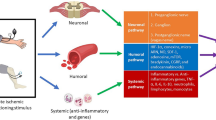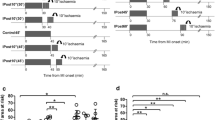Abstract
Genetically engineered mice provide an excellent tool to study the role of a particular gene in biological systems and will be increasingly used as models to understand the signal transduction mechanisms involved in ischemic preconditioning (IP). However, the phenomenon of IP has not been well characterized in this species. We therefore attempted to examine whether IP could protect isolated mouse heart against global ischemia/reperfusion (GI/R) injury. Thirty adult mice hearts were perfused at constant pressure of 55 mmHg in Langendorff mode. Following 20 min equilibration, the hearts were randomized into three groups (n = 10/each): (1) Control Group; (2) IP2.5 Group: IP with two cycles of 2.5 min GI + 2.5 min R; (3) IP5 Group: IP with 5 min GI + 5 min R. All hearts were then subjected to 20 min of GI and 30 min R (37°C). Ventricular developed force was measured by a force transducer attached to the apex. Leakage of CK and LDH was measured in coronary efflux. Infarct size was determined by tetrazolium staining. Following sustained GI/R, infarct size was significantly reduced in IP2.5 (13.8 ± 2.3%), but not in IP5 (20.1 ± 4.0%), when compared with non-preconditioned control (23.6 ± 3.8%) hearts. CK and LDH release was also reduced in both IP2.5 and IP5 groups. No significant improvement in post-ischemic ventricular contractile function was observed in either IP groups. We conclude that IP with repetitive cycles of brief GI/R is able to reduce myocardial infarct size and intracellular enzyme leakage caused by a sustained GI/R in the isolated perfused mouse heart. This anti-necrosis cardioprotection induced by IP was not associated with the amelioration of post-ischemic ventricular dysfunction.
Similar content being viewed by others
References
Murry CE, Jennings RB, Reimer KA: Preconditioning with ischemia: A delay of lethal cell injury in ischemic myocardium. Circulation 74: 1124–1136, 1986
Li GC, Vasquez JA, Gallagher KP, Lucchesi BR: Myocardial protection with preconditioning. Circulation 82: 609–619, 1990
Cohen M, Liu G, Downey J: Preconditioning causes improved wall motion as well as smaller infarcts after transient coronary occlusion in rabbits. Circulation 84: 341–349, 1991
Gross GJ, Auchampach JA: Blockade of ATP-sensitive potassium channels prevents myocardial preconditioning in dogs. Circ Res 70: 223–233, 1992
Iwamoto T, Bai X-J, Downey HF: Preconditioning with supply-demand imbalance limits infarct size in dog heart. Cardiovasc Res 27: 2071–2076, 1993
Schott RJ, Rohmann S, Braun ER, Schaper W: Ischemic preconditioning reduces infarct size in swine myocardium. Circ Res 66: 1133–1142, 1990
Liu GS, Thornton J, Van Winkle DM, Stanley AWH, Olsson RA, Downey JM: Protection against infarction afforded by preconditioning is mediated by A1 adenosine receptors in rabbit heart. Circulation 84: 350–356, 1991
Ytrehus K, Liu Y, Downey JM: Preconditioning protects ischemic rabbit heart by protein kinase C activation. Am J Physiol 266: H1145–1152, 1994
Tsuchida A, Liu Y, Liu GS, Cohen MV, Downey JM: α1-adrenergic agonists precondition rabbit ischemic myocardium independent of adenosine by direct activation of protein kinase C. Circ Res 75: 576–585, 1994
Sandhu R, Diaz RJ, Wilson GJ: Comparison of ischemic preconditioning in blood perfused and buffer perfused isolated heart models. Cardiovasc Res 27: 602–607, 1993
Jenkins DP, Pugsley WB, Yellon DM: Ischaemic preconditioning in a model of global ischemia: infarct size limitation, but no reduction of stunning. J Mol Cell Cardiol 27: 1623–1632, 1995
Baines CP, Goto M, Downey JM: Oxygen radicals released during ischemic preconditioning contribute to cardioprotection in the rabbit myocardium. J Mol Cell Cardiol 29: 207–216, 1997
Liu Y, Downey JM: Ischemic preconditioning protects against infarction in rat heart. Am J Physiol 263: H1107–H1112, 1992
Cave AC, Hearse DJ: Ischemic preconditioning and contractile function: Studies with normothermic and hypothermic global ischemia. J Mol Cell Cardiol 24: 1113–1123, 1992
Volovsek A, Subramanian R, Rebousin D: Effects of duration of ischemia during preconditioning on mechanical function, enzyme release and energy production in the isolated working rat heart. J Mol Cell Cardiol 24: 1011–1019, 1992
Das DK, Engelman RM, Kimura Y: Molecular adaptation of cellular defences following preconditioning of the heart by repeated ischemia. Cardiovasc Res 27: 578–584, 1993
Lasley RD, Anderson GM, Mentzer RM Jr: Ischemic and hypoxic preconditioning enhance postischemic recovery of function in the rat heart. Cardiovasc Res 27: 565–570, 1993
Banerjee A, Locke-Winter C, Rogers KB, Mitchell MB, Brew EC, Cairns CB, Bensard DD, Harken AH: Preconditioning against myocardial dysfunction after ischemia and reperfusion by an α1-adrenergic mechanism. Circ Res 73: 656–670, 1993
Arad M, de Jong JW, de Jong R, Huizer T, Rabinowitz B: Preconditioning in globally ischemic isolated rat hearts: Effect on function and metabolic indices of myocardial damage. J Mol Cell Cardiol 28: 2479–2490, 1996
Headrick JP: Ischemic preconditioning: bioenergetic and metabolic changes and the role of endogenous adenosine. J Mol Cell Cardiol 28: 1227–1240, 1996
Qian Y-Z, Levasseur J, Hess ML, Kukreja RC: KATP channel in the rat heart: blockade of ischemic and acetylcholine preconditioning by glibenclamide. Am J Physiol 271: H23–H28, 1996
Marber MS, Mestril R, Chi S-H, Sayen MR, Yellon DM, Dillmann WH: Overexpression of the rat inducible 70-kD heat stress protein in a transgenic mouse increases the resistance of the heart to ischemic injury. J Clin Invest 95: 1446–1456, 1995
Plumier J-CL, Ross BM, Currie RW, Angelidis CE, Kazlaris H, Pagoulatos GN: Transgenic mice expressing the human heat shock protein 70 have improved post-ischemic myocardial recovery. J Clin Invest 95: 1854–1860, 1995
Matherne GP, Linden J, Byford AM, Gauthier NS, Headrick JP: Transgenic A1 adenosine receptor overexpression increases myocardial resistance to ischemia. Proc Natl Acad Sci USA 94: 6541–6546, 1997
Barth E, Stammler G, Speiser B, Schaper J: Ultrastructural quantitation of mitochondria and myofilaments in cardiac muscle from 10 different animal species including man. J Mol Cell Cardiol 24: 669–681, 1992
de Jong JW, van der Meer P, Nieukoop AS, Huizer T, Stroeve RJ, Bos E: Xanthine oxidoreductase activity in perfused hearts of various species, including humans. Circ Res 67: 770–773, 1990
Rouslin W: The mitochondrial adenosine 5′-triphosphatase in slow and fast heart rate hearts. Am J Physiol 252: H622–H627, 1987
Xi L, Chelliah J, Nayeem MA, Levasseur JE, Kukreja RC: Whole body heat shock fails to protect mouse heart against ischemia/reperfusion injury in an isolated perfused heart model. J Mol Cell Cardiol 29: A213;235 (abstract), 1997
Chelliah J, Xi L, Okubo S, Kukreja RC: Expression of HSP72 and antioxidant enzymes in mouse heart following whole body hyperthermia. J Mol Cell Cardiol 29: A194;159 (abstract), 1997
Ovize M, Przylenk K, Hale SL, Kloner RA: Preconditioning does not attenuate myocardial stunning. Circulation 85: 2247–2254, 1992
Asimakis GK, Inners-McBride K, Medellin G, Conti VR: Ischemic preconditioning attenuates acidosis and postischemic dysfunction in isolated rat heart. Am J Physiol 263: H887–H894, 1992
Bolling SF, Olzanski DC, Childs KF, Gallagher KP: Does cardiac ‘preconditioning’ result in enhanced postischemic functional recovery? Surg Forum 42: 239–242, 1991
Gabel SA, Steenbergen C, London R, Murphy E: Preconditioning (PC) in perfused mouse hearts. J Mol Cell Cardiol 29: A229;297 (abstract), 1997
Sumeray MS, Yellon DM: Ischaemic preconditioning reduces infarct size following global ischemia in the murine myocardium. J Mol Cell Cardiol 29: A72;Th129 (abstract), 1997
Schultz JEJ, Qian Y-Z, Gross GJ, Kukreja RC: The ischaemia-selective K-ATP channel antagonist, 5-hydroxydecanoate, blocks ischemic preconditioning in the rat heart. J Mol Cell Cardiol 29: 1055–1060, 1997
Cargnoni A, Ceconi C, Bernocchi P, Pasini E, Curello S, Ferrari R: Is stunning an important component of preconditioning? J Mol Cell Cardiol 28: 2323–2331, 1996
Miura T, Goto M, Urabe K, Endoh A, Shimamoto K, Iimura O: Does myocardial stunning contribute to infarct size limitation by ischemic preconditioning? Circulation 84: 2504–2512, 1991
Matsuda M, Catena TG, Vander Heide RS, Jennings RB, Reimer KA: Cardiac protection by ischemic preconditioning is not mediated by myocardial stunning. Cardiovasc Res 27: 585–592, 1993
Yoshida T, Watanabe M, Engelman DT, Engelman RM, Schley JA, Maulik N, Ho Y-S, Oberley TD, Das DK: Transgenic mice overexpressing glutathione peroxidase are resistant to myocardial ischemia reperfusion injury. J Mol Cell Cardiol 28: 1759–1767, 1996
Wang P, Wong PC, Sankarapandi S, Qin H, Chacko VP, Zweier JL: Elevated intracellular SOD expression in transgenic mice prevents myocardial reperfusion injury. Circulation 94(8): I-279, 1625 (abstract), 1996
Ng WA, Grupp IL, Subramaniam A, Robbins J: Cardiac myosin heavy chain mRNA expression and myocardial function in the mouse heart. Circ Res 69: 1742–1750, 1991
Jennings RB, Reimer KA, Steenbergen C Jr: Effect of inhibtion of the mitochondrial ATPase on net myocardial ATP in total ischemia. J Mol Cell Cardiol 23: 1383–1395, 1991
Eddy LJ, Stewart JR, Jones HP, Engerson TD, McCord JM, Downey JM: Free radical-producing enzyme, xanthine oxidase, is undetectable in human hearts. Am J Physiol 253: H709–H711, 1987
Kukreja RC, Hess ML: The oxygen free radical system: From equations through membrane protein-interactions to cardiovascular injury and protection. Cardiovasc Res 26: 641–655, 1992
Maulik N, Watanabe M, Zu Y-L, Huang CK, Cordis GA, Schley JA, Das DK: Ischemic preconditioning triggers the activation of MAP kinase and MAPKAP kinase 2 in rat hearts. FEBS Lett 396: 233–237, 1996
Baines CP, Cohen MV, Downey JM: Protein tyrosine kinase inhibitor, genistein, blocks preconditioning in isolated rabbit hearts. Circulation 94: I-661; 3860 (abstract), 1996
Kukreja RC, Qian Y-Z: Tyrosine kinase pathway is involved in ischemic preconditioing in rat heart. J Mol Cell Cardiol 29: A230; 302 (abstract), 1997
Author information
Authors and Affiliations
Rights and permissions
About this article
Cite this article
Xi, L., Hess, M.L. & Kukreja, R.C. Ischemic preconditioning in isolated perfused mouse heart: Reduction in infarct size without improvement of post-ischemic ventricular function. Mol Cell Biochem 186, 69–77 (1998). https://doi.org/10.1023/A:1006811128561
Issue Date:
DOI: https://doi.org/10.1023/A:1006811128561




